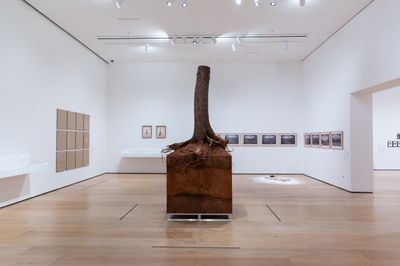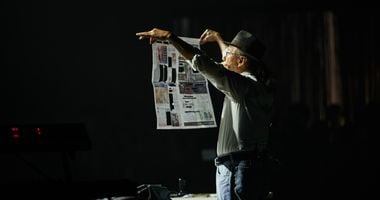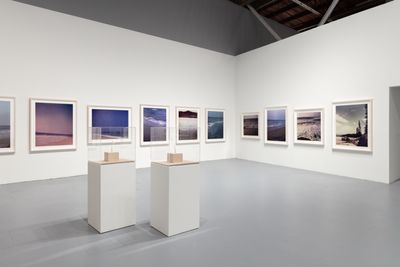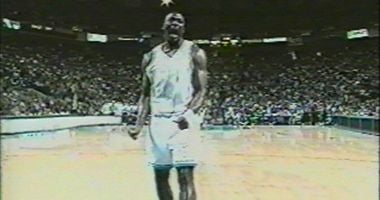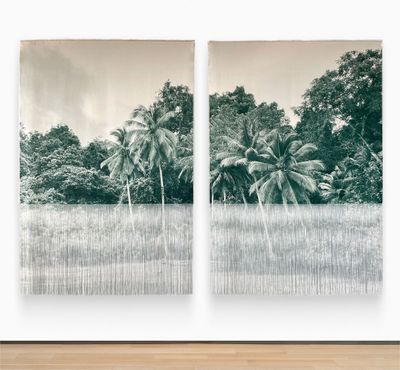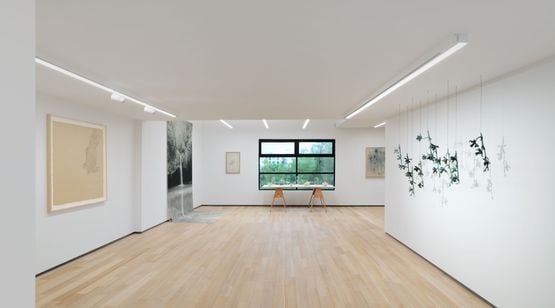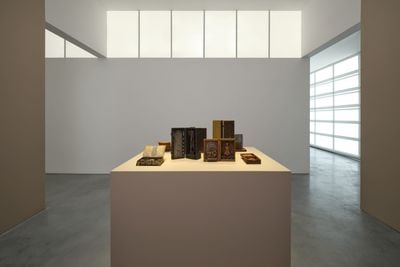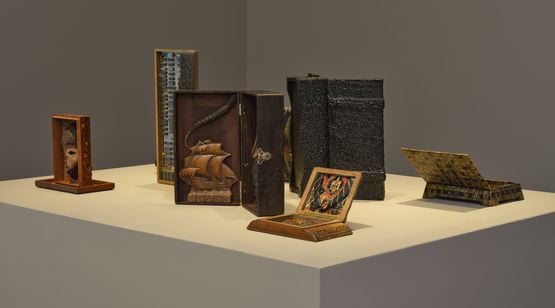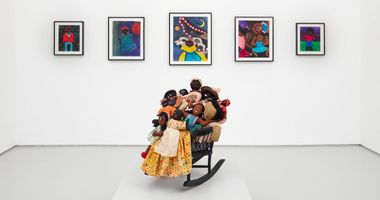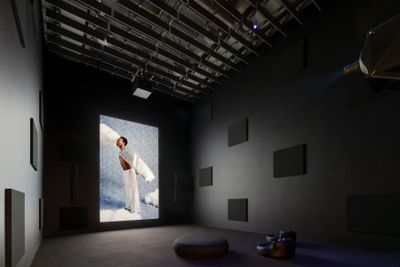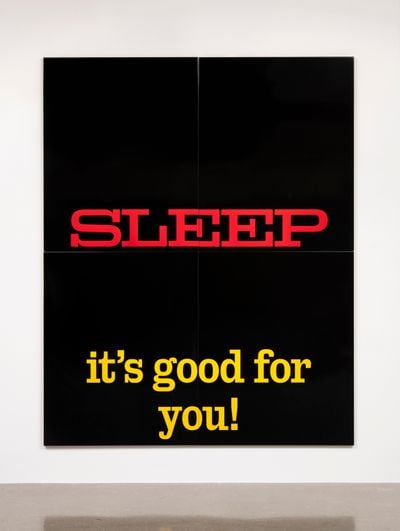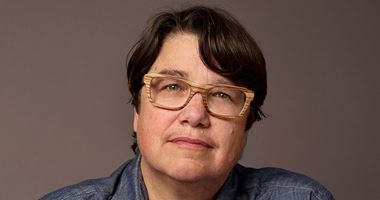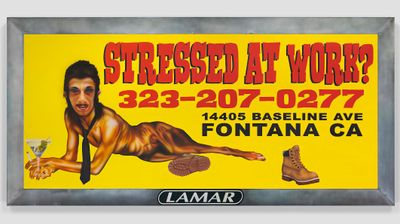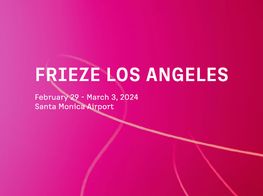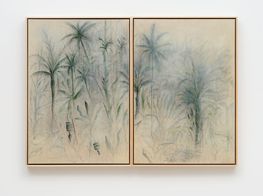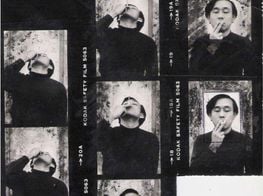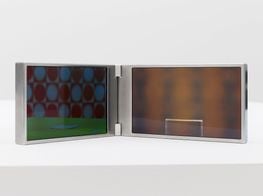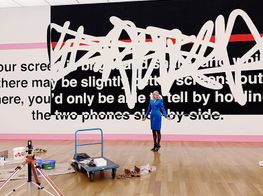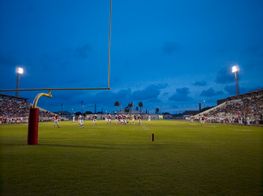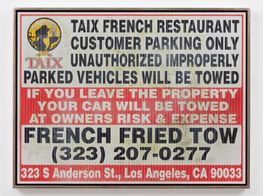8 Los Angeles Shows to See Over Frieze and Beyond, 2024
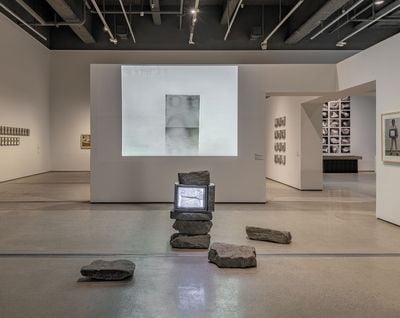
Front to back: Park Hyunki, Untitled (TV Stone Tower) (1982). Colour video (silent), CRT monitor, and stones. Dimensions variable; Untitled (Reflection Series) No. 2-6 (1979). Colour video with sound. 16 min, 43 sec. Collection of the artist's estate. Exhibition view: Only the Young: Experimental Art in Korea, 1960s-1970s, National Museum of Modern and Contemporary Art (MMCA), Seoul (26 May–16 July 2023). © Park Hyunki. Photo: MMCA.
Frieze L.A. is returning to Santa Monica Airport from 29 February to 3 March, igniting new openings throughout the city. Ocula's editorial contributors selected shows to see during the fair week, covering Paul Pfeiffer's incisive survey, an introduction to vertical cinema, new work by Betye Saar, who turns 98 this year, and never-before-seen work by Catherine Opie.
Only the Young: Experimental Art in Korea, 1960s–1970s
Hammer Museum, UCLA, 10899 Wilshire Boulevard
11 February–12 May 2024
Expect: Over 80 works by what curators have defined as 'some of the most significant avantgarde practices of the 20th century'.
Fresh from its critical success at the Solomon R. Guggenheim Museum in New York, Only the Young: Experimental Art in Korea, 1960s–1970s makes its L.A. debut at the Hammer Museum.
Dedicated to what art historian Gim Mi-gyeong termed 'Korean Experimental art' (silheom misul), Only the Young presents works by artists who came of age in the wake of the Korean War (1950–1953), and is enormously diverse in breadth, spanning photography, sculpture, painting, drawing and mixed-media, and video. It is loosely organised around various artistic groups formed during this period, such as the Avant Garde Association, Space and Time, and the Fourth Group.
Kim Kulim's early forays into assemblage in the form of painting and experimental film, The Meaning of 1/24 Second (1969) are among the show's highlights, as well as Lee Kun-Yong's Corporal Term (1971–2023)—an uprooted tree sourced locally.
Also included are works by Sung Neung Kyung that rely on the documentary characteristic of photography, such as Apple (1976) and Here (1975). His newspaper cut-out works that deal with freedom of expression are also on view.
Jung Kangja's Kiss Me (1967–2001) is among the rare works by women in the show. As co-curator Kyung An, Guggenheim Associate Curator of Asian Art, told Ocula Magazine, many women's contributions to the movement unfortunately no longer exist.
While discourse around 20th-century Korean art has often centred Informel, the avantgarde abstract painting movement of the 1950s and early 60s, and Dansaekhwa, the monochrome painting movement of the 1970s, Only the Young hones in on the pivotal period in between.
– Misong Kim
Paul Pfeiffer: Prologue to the Story of the Birth of Freedom
The Geffen Contemporary at MOCA Los Angeles, 152 North Central Avenue
12 November 2023–16 June 2024
Expect: a 25-year survey exploring the power of the image to shape individual identity and collective consciousness.
In 2000, Paul Pfeiffer's work was featured in the Whitney Biennial, and he was awarded the inaugural Bucksbaum Award, given to an artist who is believed 'to have the potential to make a lasting impact on the history of American art'. Drawing on a range of cultural and historical references and encompassing sculpture, photography, sound, and video, the exhibition that unfolds across interconnected rooms at the Geffen is an attestation to the jurors' 2000 selection.
The award-winning video installation Fragment of a Crucifixion (After Francis Bacon) (1999) is included in the opening room of the exhibition, setting the stage for the show that follows. Composed of a consumer-grade Sony device from the late nineties appended to a security arm, it projects a tiny moving image of a basketballer, arms tensed, his mouth gaping in a silent scream. The image of the basketballer is appropriated from NBA footage, which the artist has edited. Throughout the show, he digs into the spectacle of sport, Hollywood and religion.
This combination of appropriated footage and ready-made device reflects the artist's career-long interest in exploring the power of images, the mechanisms that underpin them, and the forces that drive them. Only palm-sized, Fragment of a Crucifixion captures one moment on an endless loop, drawing the audience into a viewing vortex that is all too familiar. Part of the brilliance of this show is that, despite spanning a quarter of a century, it feels absolutely of the moment.
– Anna Dickie
Ana González: VERDES
Sean Kelly, 1357 Highland Avenue
20 January–9 March 2024
Expect: González's recent textile, paintings, and sculptures issuing a gentle but unambiguous warning against the human exploitation of natural resources.
Colombian artist Ana González lived internationally in her youth, studying art and gender in Dublin, architecture in Bogotá, and photography, printing, and publishing in Paris. In an equally itinerant practice, including a trip to the Amazon with Ruven Afanador to photograph Indigenous communities, González has advocated for the preservation of nature.
Featured in González's first solo exhibition in Los Angeles, the 'Devastations' series consists of textiles on which the artist printed photos of South American landscapes and unravelled the bottom portions by hand. The landscapes disintegrate before the eye, referencing the ongoing deforestation of the Amazon that will subsequently lead to the destruction of one of the most diverse ecosystems on earth.
The series, which has previously been printed in grayscale, is now presented in a deep green spectrum.The colour is associated with nature as well as the U.S. dollar, underlining the capitalist desire behind the exhaustion of natural resources and González's call to tip the scale in favour of the verdant forests.
González's textiles are presented alongside paintings, depicting hazy, almost ephemeral trees, and delicate porcelain sculptures of flora and fauna.
– Sherry Paik
Betye Saar: New Work
Roberts Projects, 442 South La Brea Avenue
24 February–27 April 2024
Expect: new work by a pioneering local assemblage artist who has actively worked to subvert racist stereotypes in the U.S. for over 70 years.
Even at 97, Betye Saar's legacy endures. Saar was a central figure of the Black Arts Movement in the U.S. in the 1960s and 70s, who used sculpture, print, and assemblage to contest racial stereotypes of Black Americans and their historical origins.
Saar's work was political as it was personal. Assembled from objects gathered from travels and flea markets—vintage wooden boxes, birdcages, washboards, photographs—they spoke to sentiments characterising the Black female experience: rage, confinement, and faith.
Take The Liberation of Aunt Jemima (1972), which encases the Mammy figure illustrating American pancake mixes in a wooden box, holding a rifle and broom in either hand. Black Girl's Window (1969), an autobiographical work marking Saar's early foray into collage, combines images of cosmological symbols with the shadow of a young girl inside a window frame.
Discussing the artist's assemblages for Ocula Magazine in 2021, Stephanie Bailey writes, 'Even when less direct, [Saar's] material reclamation speaks to a persistent redress enacted by re-assembling fragmented bodies to stand on their own.'
Today, Saar's work is represented in over 900 exhibitions and 80 museum collections with Museum of Modern Art, New York, being the largest collector holding 42 of her early pieces.
To Frieze Los Angeles, Roberts Projects brings the artist's neon Oasis, a seminal work that debuted at MOCA Los Angeles in 1984. The original was installed above a sand dune, where 20 glass orbs surrounded a pink wicker chair lined with melted candles, recalling childhood lost childhoods and fantasies of rest, play, and escape.
– Elaine YJ Zheng
Shifting Perspectives: Vertical Cinema
Academy Museum, 6067 Wilshire Boulevard
12 November 2023–4 August 2024
Expect: an introduction to vertical cinema through historical works, three debut films by Southern Californian filmmakers, and a partnership with Ghetto Film School.
There is, arguably, no better place to stage a challenge to commercial cinema's dominant horizontal orientation than Los Angeles, the home of Hollywood. Shifting Perspectives presents the vertical format as a mode of filmmaking and watching dating back to the 1890s, later optimised by experimental filmmakers throughout the 20th century, and now made ubiquitous by the prominence of smartphones.
Three films by Southern Californian filmmakers will debut as part of the exhibition, including A DESERT DREAMS IN RED by Zaina Bseiso, Dusty Tapes by Fox Maxy, and BLACK MAN FLY by Walter Thompson-Hernández (all 2023). All three use the vertical format to explore the topography of Los Angeles, which has historically been depicted horizontally.
Bseiso's interest lies in diasporic relations to land, mysticism, and hope, informed by her Palestinian heritage, childhood in Cairo, and current life in L.A. Her film centres a water source in the Owens Valley region of Central California that has been dry since the 1920s.
Fox Maxy is a Payómkawish and Iipay filmmaker from the Mesa Grande Band of Mission Indians. Her work has screened at Sundance, TIFF, MoMA, Rotterdam, and BlackStar Film Festival, and she was named a Sundance Institute's Merata Mita Fellow in 2022. In Dusty Tapes, Maxy connects water, care, and urban development while using intergenerational exchanges and Payómkawichum musings to create a soundscape inspired by nature's aural resonance.
Born and raised in Los Angeles, Walter Thompson-Hernández was recently named one of Filmmaker Magazine's 25 New Faces of Film. His short film, If I Go Will They Miss Me, won the Sundance 2022 U.S. Fiction narrative short film prize. BLACK MAN FLY focuses on a group of friends and a local Compton pilot, exploring themes of joy, freedom, community, loss, and transformation following the pilot's death in a plane crash.
Further exploring the city's landscape are works by 15 L.A.-based filmmakers from Ghetto Film School, who documented the city through their respective experiences.
– Tendai Mutambu
Nora Turato: it's not true!!! stop lying!
Sprüth Magers, 5900 Wilshire Boulevard
28 February–27 April 2024
Expect: an investigation into cultures of self-optimisation that includes a performance scrutinising notions of self-improvement and self-care.
Following from her 2023 commission for Performa Biennial and solo exhibition at Sprüth Magers, Berlin, Nora Turato presents her latest body of work, pool 6, which continues to explore cultures of self-optimisation and corresponding anxieties.
Turato is well known to work with language and engage with its volatility. Flickers of everyday life from articles, conversations, subtitles, and political slogans often find their way into her videos and installations, books and spoken performances, alongside the artist's handwriting.
At Sprüth Magers, a new video work questions 'self-betterment and self-governing, success and competition, the monetisation of life and reality', while glossy enamel panels posit Holzer-like assertions, only more explicit. 'I NEED SOME HEALING,' reads one, 'this isn't me'.
An accompanying performance examines ideas of self-improvement and self-care. Both, according to the artist, have led to practices of self-aggrandising, rather than communal connection and care for the marginalised, as the latter term originally intended.
– Elaine YJ Zheng
Catherine Opie: harmony is fraught
Regen Projects, 6750 Santa Monica Boulevard
11 January–3 March 2024
Expect: a first look at more than 60 photographs and a new video work by an acclaimed photographer who has captured L.A.'s many faces since the 1990s.
American photographer Catherine Opie has questioned the different facets of American culture and identity for over three decades.
'Curiously, despite the quarter of a century or more that separates us from the moment of their making, many of these images seem to proffer the same city we know now,' Regen Projects notes on the artist's 11th exhibition with the gallery.
Los Angeles and its communities appear throughout the artist's work, from the early 1991 series 'Being and Having', in which Opie and her queer female friends are photographed performing masculinity, to the artist's later focus on local landscape, freeways, and shopping malls.
'Photography can be used to question systems, or ideas around representation. I'm always pushing that, both through portraiture and landscape,' the artist told Ocula Magazine in 2018.
In the artist's studio portraits, subjects from both mainstream and marginal cultures display and perform their identities, often to jarring effect. Symbols become costumes of sorts, as they become decontextualised, amplifying the individual and collective makings of identity.
– Elaine YJ Zheng
At the Edge of the Sun
Jeffrey Deitch, 925 North Orange Drive
24 February–4 May 2024
Expect: a collaborative exhibition between artists who have known each other for over a decade, seeking to showcase the many faces of Los Angeles.
Twelve artists conceived At the Edge of the Sun in discussions over the past year. The resulting exhibition offers an intimate view of Los Angeles, its landmarks, memories, and communities.
Spotlighting local interests and the city's Latinx-inspired culture—from murals to tattoos and cars—the exhibition includes lesser-seen mediums such as hand-sign painting, car customisation, truck detailing, adobe construction, and small-scale ceramics.
Recalling old-school commercial signage, Mario Ayala's three-metre-long Billboard (2022) shows an ad aimed at those exhausted by work. Referring to Lamar advertising company, the image presents a nude man with dog-like legs lounging with a martini glass and a cigarette.
The city's underground economies, landscapes, nightlife, and architecture inform other works on view. To expand the show beyond the gallery walls, the artists invited designers, filmmakers, writers, and photographers to contribute to the exhibition.
– Sam Gaskin

